10th February 2013
1st lunch of Lunar Calendar year of Snake (农历大年初一)- Part 1
In contrary to the wide choices of Chinese meals available at various food outlets during the eve of CNY, it was hard to find any decent Chinese meals on the first and second day of CNY; not even the Chinese hawker/street foods! In Penang, many of the Kopitiam, hawker centres and restaurants would close for at least 2 days before resuming business on the third or fourth day of CNY. Having our CNY lunch at home on the first day was almost always our only alternative.
Since Mum’s passing, my second sister-in-law, Lai Cheng has taken over the task of manning her kitchen during festive days. With my return, she was so glad to have extra helping hands in preparing the CNY lunch. This year, when I noticed she had bought some expensive seafood materials such as sea cucumber, frozen baby abalone and fish maw, it gave me the idea to make them into Hakka Pen Cai, the deluxe version as compared to what was usually served in restaurants.
Pen Cai (盆菜) or Big Basin Feast is one of Hakka delicacy cuisine commonly served during CNY, or other festive days and weddings. This communal dish was made popular by Hong Kong New Territories Hakka Village. Hakka people in the olden days mostly resided in the hills and was well known for their frugal lifestyle.
The original version of Pen Cai only used basic and fresh ingredients that were easily available from their farms, i.e. vegetables, chicken, duck and pork. However, nowadays this dish has transformed into an exotic and lavish dish by restaurants with the addition of seafood such as oysters, abalone, sea cucumber, fish maw and scallops.
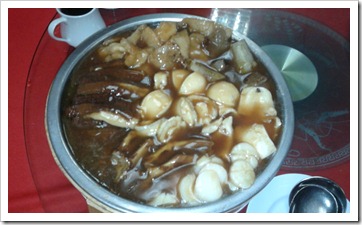 |
| Restaurant Pen Cai - Deluxe version |
I did some Google search for the recipes on how to cook sea cucumber, baby abalone and fish maw. I seldom used these expensive ingredients and was afraid I might ruin them. Frankly, it was kind of an impromptu decision to try out this dish. We didn’t have quite a few of the usual Pen Cai ingredients such as variation of vegetables and bean curbs, so we had to make do with whatever veggies we had in the fridge.
I was glad that JS gave us a hand in arranging the cooked ingredients into the metal basin. The reason why I asked hubby to take over this task was because when in Auckland, there were stalls serving Chinese food in buffet style charging by per serving by the size of the plate. We would pay for the price of a single serving regardless of the amount of food stacked on the plate. JS always managed to stack so much food in that small plate that many times made such meals good value for money!
Shared below was the homemade Hakka Pen Cai (客家盆菜) that we improvised from the ingredients that we had on hand. In fact, to me Pen Cai had no fixed recipe; you can opt to put in any ingredients you like in the basin.
What’s more important was how to arrange them in a basin. The key to note was to ensure the absorbent ingredients at the bottom of the basin. Traditionally, the bottom layer was always stuffed with vegetables with plain taste such as Chinese cabbage, radishes, pigskins and bean curd. The middle layers were usually pork and Chinese dried mushroom. On the upper part of Pen Cai, meat, seafood and luxurious ingredients such as abalone, oyster, scallops and sea cucumber were placed.
Don’t be put off by the long and daunting list of the ingredients and steps. Though preparing Pen Cai can be tedious and time consuming, I think it is still acceptable to do it once a year.
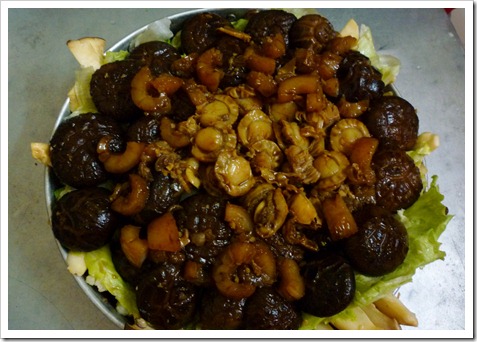 |
| Pen Cai 客家盆菜 - Yinhomemade version |
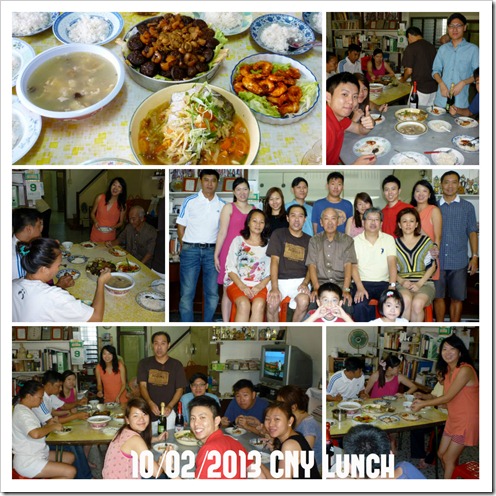 So, what were the feedbacks from my family members?
So, what were the feedbacks from my family members? Next year, SIL and I had planned to make it more flavourful with proper veggies and added with more meat and starchy gravy!
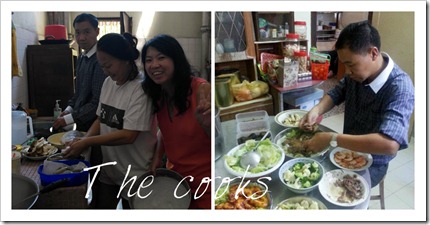
|
Ingredients for A – Dried Mushroom
Dried Shiitake mushroom (pre-soaked and de-stemmed)
water
1. Cover the mushroom with water and stew for an hour until mushroom texture turned soft
2. Drain and set aside the mushroom soup for use in making Pen Cai sauce
Ingredients for B - Seafood
Sea Cucumber
Sea cucumber (ready to use), sliced, pre-blanched
Some slices of shallots
Spring onion
Some water
1. Sauté spring onion and shallots until fragrant and add in water to bring to boil
2. Add in sea cucumber and stir fry for a while, dish up and drain to set aside.
This is to do away the fish smell of sea cucumber.
Baby Abalone
1. Defrost the frozen fresh baby abalone; use some sea salt to wash the abalone.
Dried fish maw
1) Soaked in hot water for 20minutes or until fish maw feel soft
2) Cut into ~3cm width each
Ingredients for H – Prawns
large prawns (trimmed)
1) You can either steam or stir fry prawns with a bit of salt and set aside.
Seasoning for C
4 cloves of garlic (minced)
20g ginger (shredded)
2 tbsps. Oyster Sauce
1 tbsp. light Soya Sauce
1/2 tbsp. sugar
2 tbsps. Chinese cooking wine
Mushroom soup from A
corn-starch mixture (combine well)
Directions for C
1) Heat oil in wok.
2) Sauté garlic & ginger and stir-fry until fragrant.
3) Add seasonings D except corn starch mixture, pour in B sea cucumber, and bring to boil.
4) Reduce heat and simmer for 5 minutes, dish up sea cucumber and set aside.
5) Pour in fresh baby abalone and simmer for 1-3 minutes, dish up and set aside.
(Not advisable to cook baby abalone for more than 5 minutes, else it will taste rubbery and hard)
6) Next place in fish maw and simmer until texture soft, dish up and set aside.
7) Lastly, pour in corn starch mixture to thicken the sauce. Set aside to use.
Ingredients for D – Meat
Duck
We used Braised duck/ Lo Ark
(SIL prepared in advance, click here for Teo Chew Braised duck recipe)
1) Debone duck, and set aside.
Chicken/Pork
You can opt to put in roasted pork belly - check out my signature Crispy Roasted Pork Belly recipe.
Or Roasted Chicken
Ingredients for E - Mushroom
2 tbsps oil
2 cloves garlic (minced)
Pinch of salt
Fresh Mushrooms ( I do not know the name of mushroom we used, the type with fat stalk), sliced
1) Heat oil in wok. Add garlic sauté garlic until fragrant.
2) Add in stalk mushroom and sprinkle salt and stir fry for a minute or two
3) Dish up and set aside to be used.
Ingredients for F – Vegetables /Broccolis/Cauliflowers
Lettuce
Cabbage (roughly cut & blanched)
broccoli (blanched, cut into florets)
Cauliflower/carrots (blanched, sliced)
A pot of water
pinch of salt
1 tbsp. cooking oil
Directions for F:
1) Bring a pot of water to boil. Add in cooking oil
2) Put in broccoli and cauliflower add in salt and blanched, drained and set aside
Assembly :
1) Use a big bowl or basin – Preferably metal/clay pot/Casserole ( can reheat at stove)
2) Assemble lettuce/cooked cabbage at the bottom of the basin.
3) Placed deboned braised duck with the gravy on top over the vegetables.
4) Placed another layer of lettuce over and pour over the sauce
5) Assemble prawns on top of the lettuce before add in broccoli and cauliflowers
6) Assemble another layer of stalk mushrooms at the rim and add in shiitake mushroom in the middle.
7) Final layer top with the premium ingredients Sea cucumber, fresh baby abalone and fish maw.
8) Pour in all gravy, reheat and simmer for 5-10 minutes. (Check not to let gravy dry up).
9) Serve hot.
盆菜
成份A – 干花菇
干香菇(预浸软,去梗) 水 1。把水覆盖蘑菇,炖一个小时,直到蘑菇质地软 2。蘑菇沥干备用, 蘑菇的汤倒起备用 成份B - 海鲜 海参 (买已发的海参可以直接使用的),切片 一些青葱 葱头仔 适量水 1。把葱头仔和青葱爆香,加入水,煮滚 2。加入海参,煸炒一会儿,盛起,沥干搁置。 这是为了去掉海参的鱼腥味。 小鲍鱼 1。解冻鲜鲍鱼,使用一些海盐清洗鲍鱼。 干花膠/鱼鳔 1)20分钟在热水中浸泡,直到花膠质地软 2)切成3cm的长度 成份H - 虾 大明虾(修剪) 1)你可以加一点盐蒸或翻炒虾,搁置备用。 调味料C 蒜头4瓣(切碎) 适量姜(切丝) 2汤匙。蚝油 1汤匙。酱油 1/2汤匙。糖 2汤匙。中国料酒 A蘑菇汤
太白粉水
烹调方法C 1)热油入锅 2)爆香蒜头和姜丝。 3)加入调味料C除太白粉水,倒入B中的海参,煮滚。 4)减小火煮5分钟,盛起海参,搁置备用。 5)倒入小鲍鱼,小火煮1-3分钟,捞起,备用。 (不建议超过5分钟,否则小鲍鱼质地会变胶硬) 6)接下放入花膠煨,直到质地较软,捞起,备用。 7)最后,倒入太白粉水将汁变稠。搁置备用。 D - 肉类配料 鸭 我们用二嫂提前做好的卤鸭 ,(潮州卤鸭配方) 1)去鸭骨,搁置备用。 你也可以选择加入/烧猪肉或烤鸡肉。 (脆皮烧花肉配方)。 E - 蘑菇配料 2汤匙油 2瓣蒜头(切碎) 少许的盐 鲜蘑菇(我们使用有的柄蘑菇,不知道它的名称)切片 1)热油入锅。爆香蒜头。 2)加入蘑菇,撒上盐,翻炒一两分钟搁置备用。 F - 蔬菜配料/西兰花/菜花 生菜 白菜(粗切和烫) 西兰花(烫一下,切成小花) 花椰菜/胡萝卜(烫一下,切成薄片) 一锅水 少许盐 1汤匙。烹调油 烹调方法F: 1)把锅里的水烧开。加入烹调油 2)将西兰花和菜花在盐水中烫一下,沥干,搁置备用。 排盘: 1)使用一个大的碗或盆 - 最好的金属/粘土锅/砂锅(可以再热用的) 2)将生菜/熟白菜排放在盆地底部。 3)加上去骨的卤鸭和肉汁在上面。 4)再加上另一层生菜倒如酱汁,才添加大虾。 5)按次添加西兰花和花椰菜后。
6)组装另一层在菜上,并在中间加入香菇柄香菇。
7)最后一层顶部的优质原料海参,鲜鲍鱼和鱼肚。 8)所有肉汁倒入,小火煮再热, 5-10分钟。 (检查,不要让肉汁干涸)。 9)趁热食用。 |


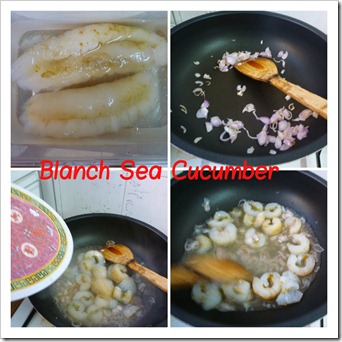
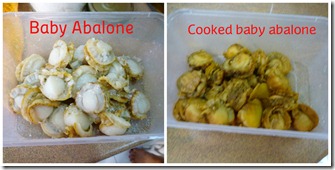
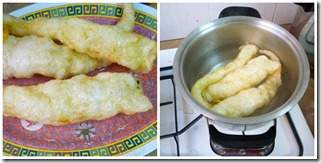
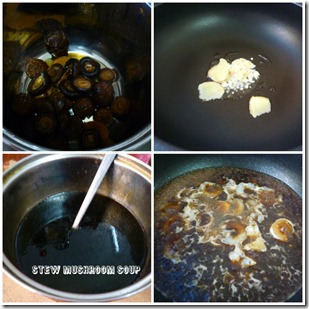
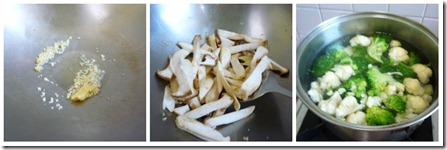
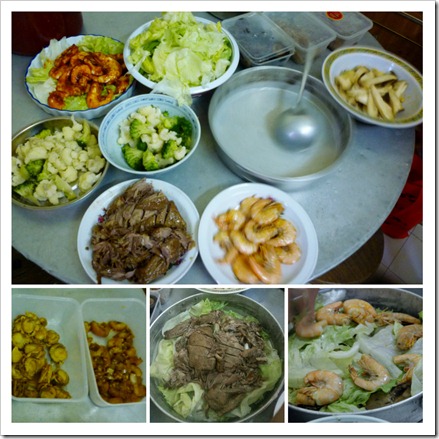
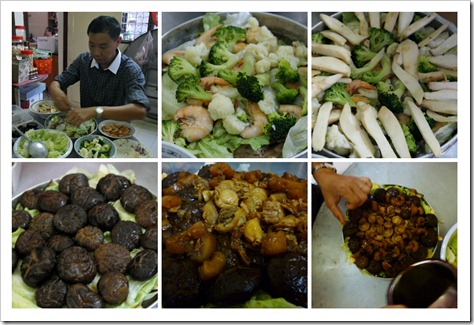

No comments:
Post a Comment